Skyscraper Concrete Programming
To prepare concrete is very simple. Take cement, water and sand, a pinch of rubble, mix. Done! Is it possible to build something from the resulting solution? Of course. Is it possible to build a unique building from it? Not.
What's wrong with this mix? Let's go to the construction site of the St. Petersburg "Lakhta Center" and find out. Today's post is about the second of the three "components" of the tower. Learn about the first glass, here .

( Photo Source )
Big cities are often called the concrete jungle. This eloquently testifies to which building material is the most common today.
')
Most concrete is loved in Asia. By force, because of the expensive steel. There, skyscrapers are built almost entirely of concrete - for example, the Petronas towers in Kuala Lumpur.

These "twins" weigh twice as much as if they had a steel frame. But far less than if they had been built just a decade earlier. What happened on this gap?
***
Finding a balance between the load bearing capacity of the ground and the weight of a super heavyweight building is always a challenge. The history of the towers in Kuala Lumpur is indicative here - they are not only “concrete-heavy”, but also stand on pliable limestone. Probably, if they were erected by less competent engineers and builders, the employees of Petronas would have long known what the magma looks like. But under the towers - 100-meter piles, and the weight of buildings significantly lightened due to the high-strength modified concrete. Will be in Kuala Lumpur - go without fear.

( Photo Source )
Modified concrete exactly had to come up somewhere in the east of Asia. In a region where soils are weak and seismically active, every piece of land is worth its weight in gold and a cubic meter of steel — about the same, but everything is fine with brains and technology. The revolutionary situation was not long in coming. The breakthrough was made by the Japanese in the late 1980s and early 90s. The invention - special additives in concrete. They made it high strength and opened the era of concrete "programming". Now the properties of concrete can be preset using construction chemicals.

Cityscapes in Asia. ( Photo Source )
The quality of classic concrete depends on the consumption of cement. The properties of high strength concrete depend on additives.
As the name suggests, the main criterion for new concrete is increased hardness. This is a minimum class B40, compressive strength of 60 MPa and above. In Russia, the most high-strength concrete - B90, declared on the construction of the complex "Moscow City".
Concrete mix consists of solid, liquid and gaseous substances - air, water, cement, large and small aggregates. The size of solids can differ from each other in a million times.

The main components of the concrete solution
Will the mixture in principle, depends on the ratio of solid particles and water. If it is optimal, the water molecules will surround the solid particles, condense and form bonds with each other - a crystal structure. If there is more water than necessary, there will be a separation: puddles above and coarse fractions below. With a shortage of water, too, nothing will come of it.
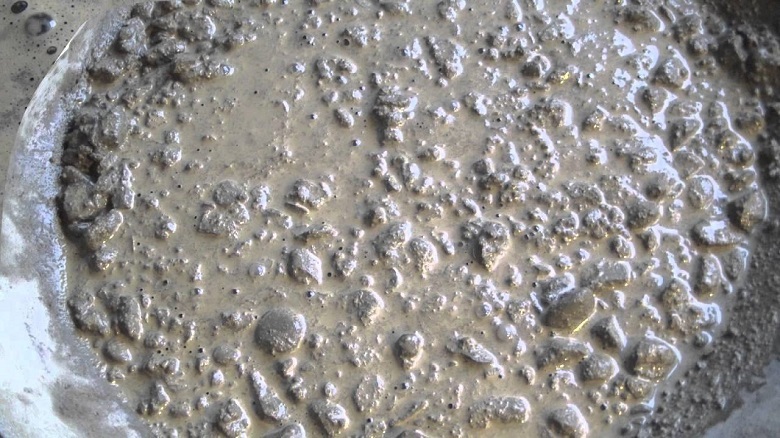
Stratification mixture
If the solution turned out, then the next danger is capillary pores.
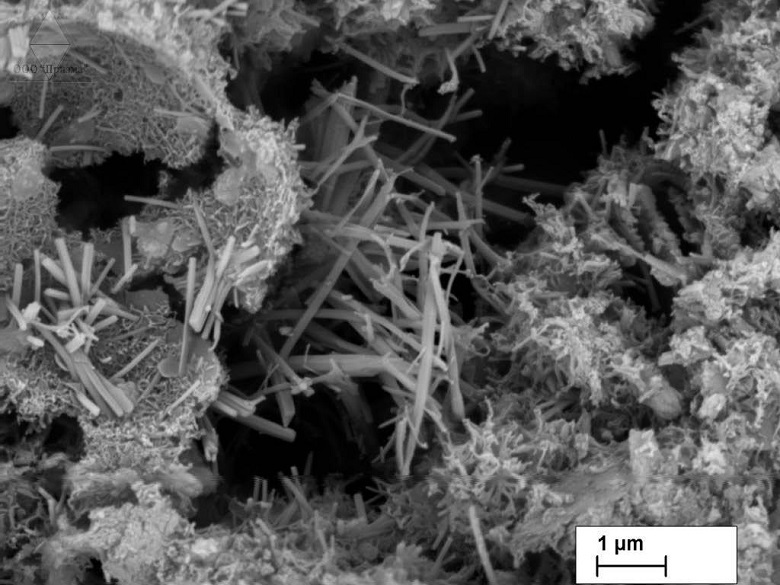
Here they are. (Photo from here )
These are cavities, ranging in size from 0.01 to 10 µm, filled with water. After the water is tightened into the structure, a vacuum occurs in the cavities. Water or air from the environment is drawn in there. At minus 2-3 ° C, the water in the pores freezes and increases in volume. Ice "tears" the concrete. After several cycles of freezing, microcracks are formed.
Pores - the main defect of concrete. Fortunately, almost all of them are concentrated in one place - cement stone.
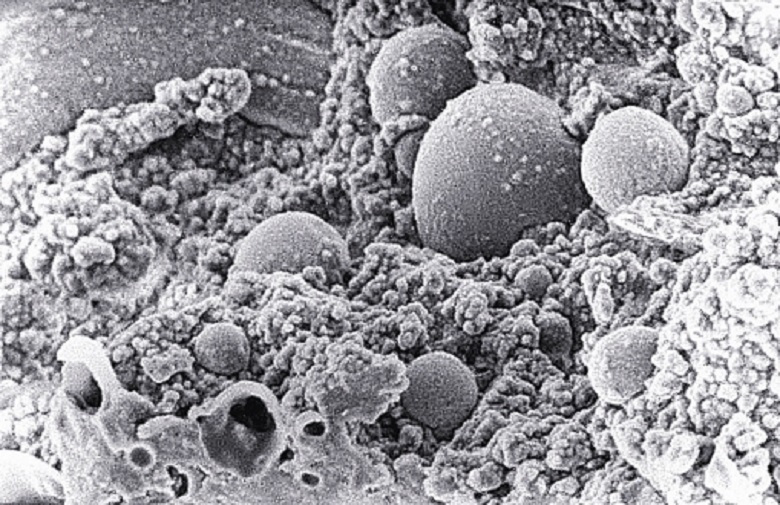
Fragment of pore space of cement stone ( Photo Source )
The volume of cement stone in concrete is 25-30%. He is the weakest link. If it is less or not at all - the porosity will decrease. It is on this target that the additives are beaten.
For example - silica fume. These are spherical silica particles about 0.1 microns in size. Thousands of such granules surround the cement grains, compact the mixture, filling all voids.
Another group - superplasticizers (polymers). Increase the mobility and fluidity of the mixture. Form the structure of concrete at the initial stage, reducing the volume of cement stone.
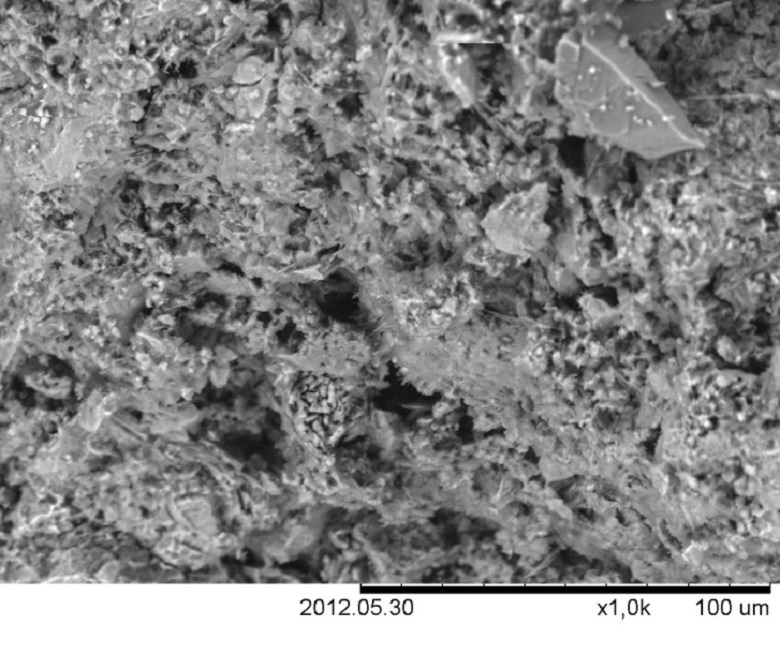
Cement stone, age - 28 days, an increase of 1000 times.
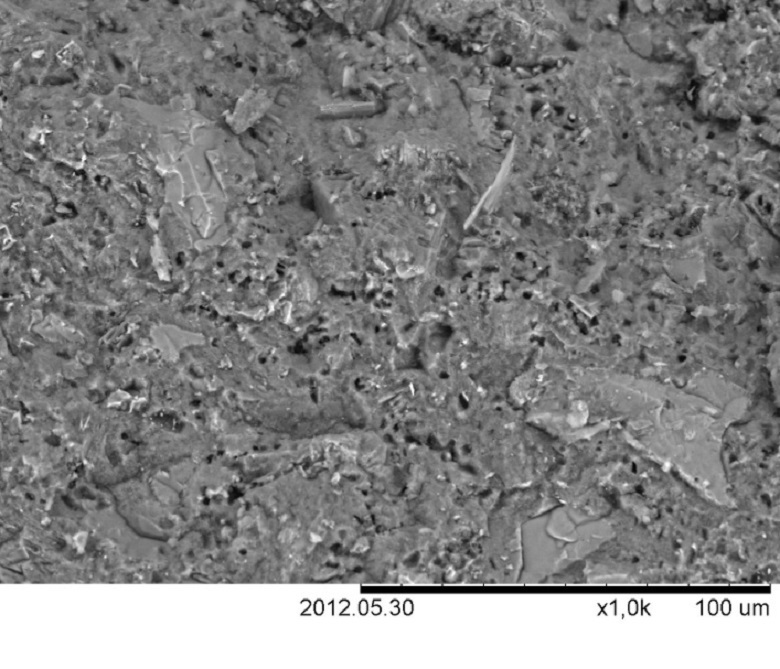
Cement stone, with the addition of silica fume. Age - 28 days, an increase of 1000 times. Both photos from here
The Pantheon and with cement stone has been feeling fine for two thousand years. Built from ordinary concrete. Something is wrong here.
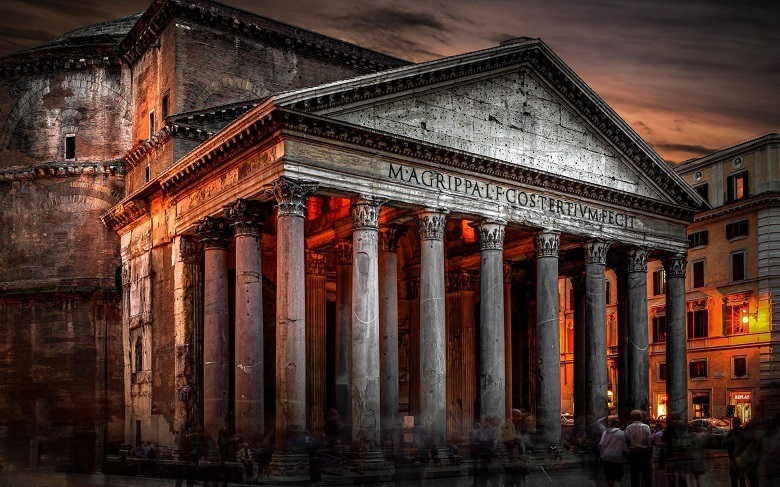
Pantheon, Rome. Commissioning - 126 AD. (Photo from here )
Firstly, in Rome is not cold. But this is not important. The main thing - the ancient Romans did not build skyscrapers. They had no task to reduce the weight of the structure and the load on the ground. Modern skyscrapers - every ton counts.
High-strength concrete weighs as usual - all the same 2200-2500 kg / m3. But the final weight of the structure is significantly reduced. This is due to the reduction of cross-sections and the number of reinforcement.
This is a calculation for a simple high-rise. We transfer in rough approximation these results to the scale of a skyscraper. This is truly a revolution!
With the help of additives, it is now possible to pre-design other qualities - frost resistance, resistance to chemical aggression, to make concrete movable, to change the setting time. Now he can even fit himself.
We will understand all the subtleties on the example of the largest and most complex monolithic concrete structure in Russia.
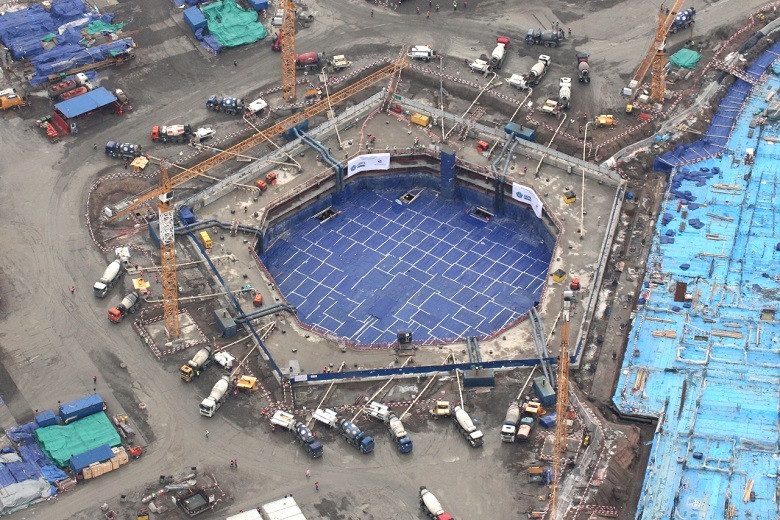
The bottom plate of the box base of the tower "Lakhta Center". Area - 5700 sq. M. Thickness - 3600mm, materials - fittings, A500 steel, concrete - B60
For the lower foundation slab "Lakhta Center" was the holder of the record for the most voluminous continuous pouring of concrete - 19,624 cubic meters in 49 hours.
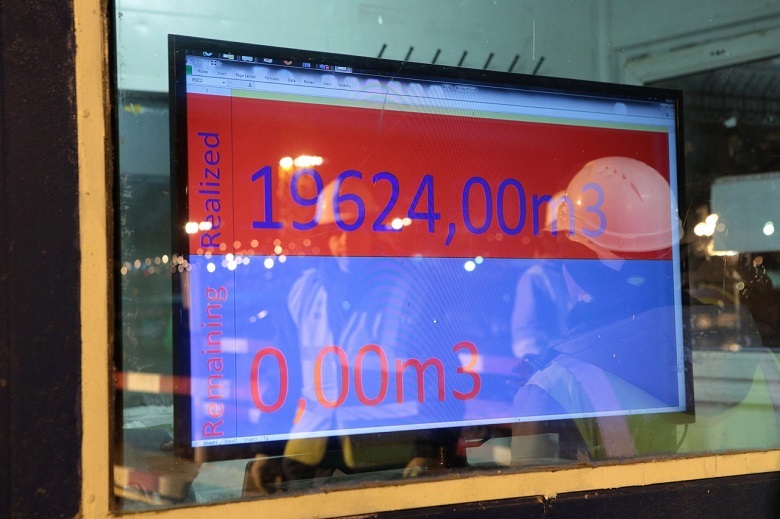
03/01/2015
A year and a half later, in 2016, achievement surpassed in the Emirates - they have 169 cubic meters more and 4 hours faster. Under the entry in the KRG, the first number is an insistent request to clarify whether the Russian record is precisely broken. Yes, friends, high-rise construction does not stand still, and that's fine. However, plates like ours and Dubai, in the world so far - count on your fingers.
So, twenty thousand cubic meters in two days. One of the secrets of speed - SUB, self-compacting concrete.
The classic case looks like this: workers stand in a concrete spill and compact the mixture using vibrators.

A diligent builder changes vibrators and the speed of vibrations - in his hands the quality of the design. The process is long and very time consuming. SUB compacted itself. At this point you can put an end. But still I will continue - there are even more compelling reasons for.
Reason number 1 - seams
The laying speed is needed, of course, not for the sake of records. In concreting, there is the concept of “cold joint” - the boundary between the set and freshly filled solutions. This is the future weak spot. It is torn at the seam - not only about the fabric.
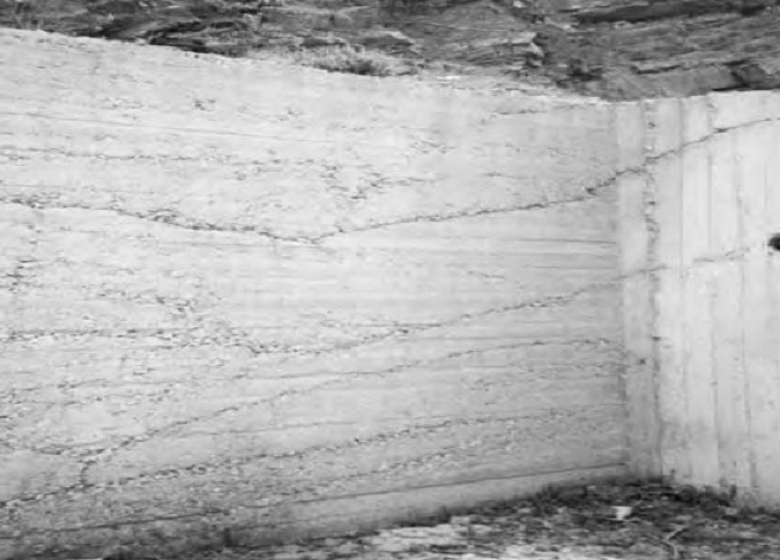
Cold seams. Illustration from the book Self-Compacting Concrete by Geert De Schutter, Peter JM Bartos, Peter Domone & John Gibbs
Reason number 2 - the volume of construction
Suppose it was possible to vibrate the first layer quickly, in less than 5 hours required to form a seam. Pouring continues. After some time, the concrete "pond" reaches a depth of 1 meter. Wading with a vibrator will not work - now you just have to wait until the mixture hardens. Returning to reason number 1.

Large volume
Reason number 3 - valves
All constructions of “Lakhta Center” are densely reinforced. In the bottom plate –15 coaxially located grids. To work with a vibrator in such conditions is absolutely no possibility.
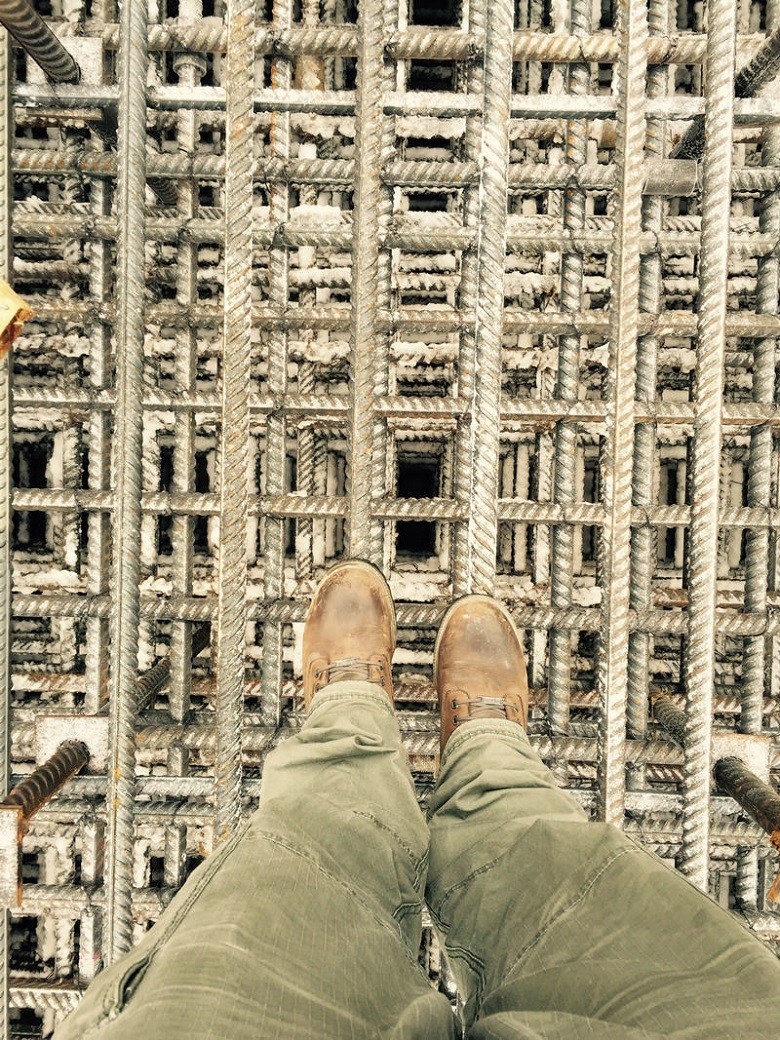
Reinforcement of the bottom plate of the box foundation of the tower "Lakhta Center"
The SMS is compacted by its own weight. It, like a viscous fluid, fills even the most densely reinforced form. The mechanism of operation provides the addition of superplasticizers - polycarboxylate particles surround the surface of the cement grains and give them a negative charge. Grains repel each other from each other, the solution moves without any vibration.
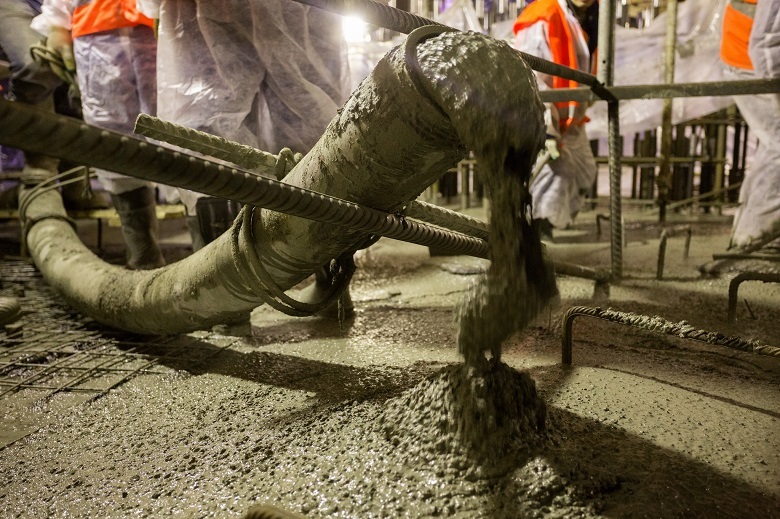
The behavior of the SMS on the pouring of the slab - the mixture gently envelops the reinforcement
How mobile the SMS is can be understood from the comparison. There is such a test - the mixture is poured into the measuring cone, turned over, removed and measured, as far as the donkey or the cone has spread. The indicator is called OK - sediment cone. OK for high-strength and highly mobile concretes - 22-24 cm. At the SUB, which was used in Lakhta, the cone did not “sit down”, but spread out with a spraying diameter of 60-65 cm!
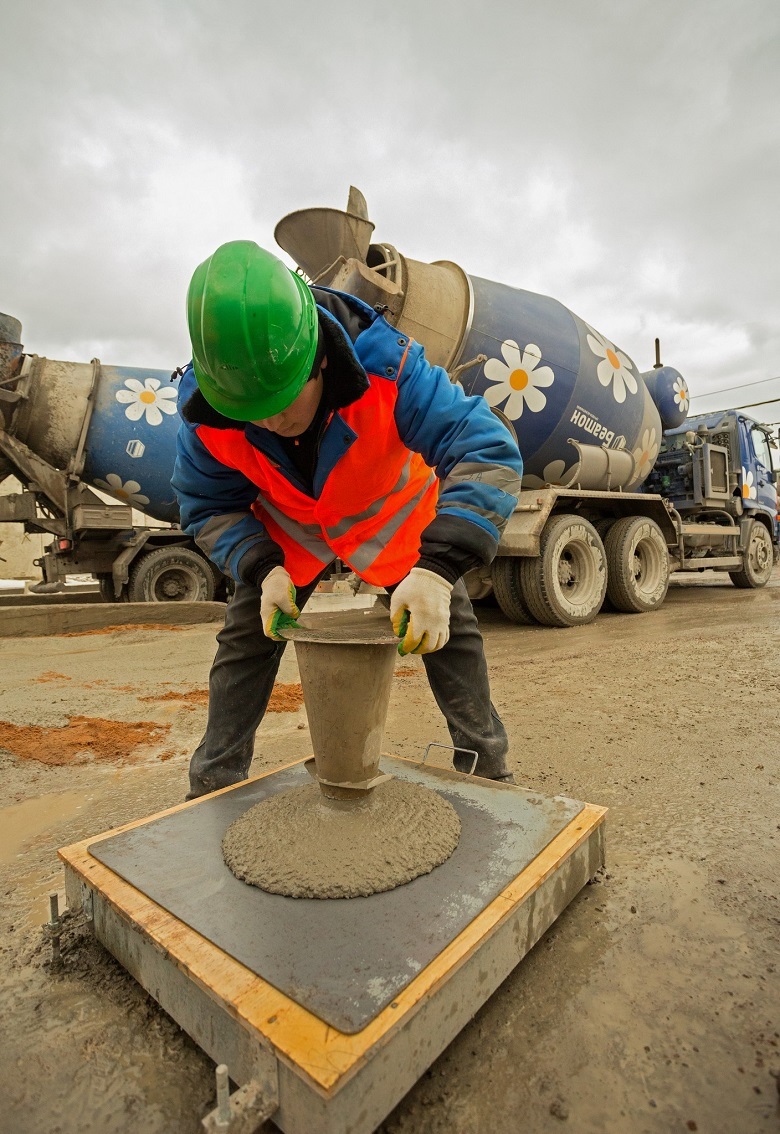
Cone Spreading Test
Of course, such a “magic” mixture requires both accurate calculation and first-class components. For example, the SUB, larger than other concretes, depends on the shape and size of the fractions. If the coarse aggregate has an oblate shape of particles, they will create congestion in the concrete “river”. The rest of the mixture can be perfect - and still, as it should not work out.
If you ever asked in comments about local materials or technologies, here it is - this is the case. Concrete is always a local product. In the complex “Lakhta Center” - 400 thousand cubic meters of concrete produced here and now.
The reason is simple - components for the concrete mix can not be stored for a long time. Cement will spoil, sand - will damp. The finished solution has only 2-3 hours from the moment of mixing to either lie down in the structure or go to the scrap. Foreign countries will not help here.
And this is a problem. In the market they sell what they buy. In St. Petersburg, buy a mixture of classes B25-B30 - classic concrete for ordinary civilian buildings. B25-B30 is not a synonym for poor quality, it can be on top. But this automatically means that you cannot come to any place and just buy concrete for a skyscraper. We must go on reconnaissance - look for components, experiment with the recipe, look for suppliers.

You can’t just buy and buy concrete anywhere — not for your home or for a skyscraper.
***
Read in the next post - why it is impossible to pour sand into the mixture from the Gulf of Finland - close and convenient? Granite gravel did not fit in the aggregates. What to do? Smelly concrete additives - true or not? After what time can you walk on the concrete and not get stuck?
-
Consultant:
V.M. Lukin - project manager for reinforced concrete structures "Lakhta Center"
What's wrong with this mix? Let's go to the construction site of the St. Petersburg "Lakhta Center" and find out. Today's post is about the second of the three "components" of the tower. Learn about the first glass, here .

( Photo Source )
Big cities are often called the concrete jungle. This eloquently testifies to which building material is the most common today.
')
Most concrete is loved in Asia. By force, because of the expensive steel. There, skyscrapers are built almost entirely of concrete - for example, the Petronas towers in Kuala Lumpur.

These "twins" weigh twice as much as if they had a steel frame. But far less than if they had been built just a decade earlier. What happened on this gap?
***
Finding a balance between the load bearing capacity of the ground and the weight of a super heavyweight building is always a challenge. The history of the towers in Kuala Lumpur is indicative here - they are not only “concrete-heavy”, but also stand on pliable limestone. Probably, if they were erected by less competent engineers and builders, the employees of Petronas would have long known what the magma looks like. But under the towers - 100-meter piles, and the weight of buildings significantly lightened due to the high-strength modified concrete. Will be in Kuala Lumpur - go without fear.

( Photo Source )
CONCRETE REVOLUTION
Modified concrete exactly had to come up somewhere in the east of Asia. In a region where soils are weak and seismically active, every piece of land is worth its weight in gold and a cubic meter of steel — about the same, but everything is fine with brains and technology. The revolutionary situation was not long in coming. The breakthrough was made by the Japanese in the late 1980s and early 90s. The invention - special additives in concrete. They made it high strength and opened the era of concrete "programming". Now the properties of concrete can be preset using construction chemicals.

Cityscapes in Asia. ( Photo Source )
HIGH STRENGTH CONCRETE. HOW IT'S MADE
The quality of classic concrete depends on the consumption of cement. The properties of high strength concrete depend on additives.
As the name suggests, the main criterion for new concrete is increased hardness. This is a minimum class B40, compressive strength of 60 MPa and above. In Russia, the most high-strength concrete - B90, declared on the construction of the complex "Moscow City".
Concrete mix consists of solid, liquid and gaseous substances - air, water, cement, large and small aggregates. The size of solids can differ from each other in a million times.

The main components of the concrete solution
Will the mixture in principle, depends on the ratio of solid particles and water. If it is optimal, the water molecules will surround the solid particles, condense and form bonds with each other - a crystal structure. If there is more water than necessary, there will be a separation: puddles above and coarse fractions below. With a shortage of water, too, nothing will come of it.

Stratification mixture
If the solution turned out, then the next danger is capillary pores.
Here they are. (Photo from here )
These are cavities, ranging in size from 0.01 to 10 µm, filled with water. After the water is tightened into the structure, a vacuum occurs in the cavities. Water or air from the environment is drawn in there. At minus 2-3 ° C, the water in the pores freezes and increases in volume. Ice "tears" the concrete. After several cycles of freezing, microcracks are formed.
Pores - the main defect of concrete. Fortunately, almost all of them are concentrated in one place - cement stone.

Fragment of pore space of cement stone ( Photo Source )
The volume of cement stone in concrete is 25-30%. He is the weakest link. If it is less or not at all - the porosity will decrease. It is on this target that the additives are beaten.
For example - silica fume. These are spherical silica particles about 0.1 microns in size. Thousands of such granules surround the cement grains, compact the mixture, filling all voids.
Another group - superplasticizers (polymers). Increase the mobility and fluidity of the mixture. Form the structure of concrete at the initial stage, reducing the volume of cement stone.

Cement stone, age - 28 days, an increase of 1000 times.

Cement stone, with the addition of silica fume. Age - 28 days, an increase of 1000 times. Both photos from here
WHY IS A REVOLUTION?
The Pantheon and with cement stone has been feeling fine for two thousand years. Built from ordinary concrete. Something is wrong here.

Pantheon, Rome. Commissioning - 126 AD. (Photo from here )
Firstly, in Rome is not cold. But this is not important. The main thing - the ancient Romans did not build skyscrapers. They had no task to reduce the weight of the structure and the load on the ground. Modern skyscrapers - every ton counts.
High-strength concrete weighs as usual - all the same 2200-2500 kg / m3. But the final weight of the structure is significantly reduced. This is due to the reduction of cross-sections and the number of reinforcement.
Here is how it looks in concrete numbers.
Researchers E.E. Koryakin and V.N. Aksenov from the Russian State Social University, carried out calculations on columns on the first two floors in a residential building on Stadionnaya Street (Rostov-on-Don). The first calculation - with the classic concrete B25, the second - with high-strength B80. The size of the column sections was reduced from 600 * 600 mm to 400 * 400 mm. The mass of reinforcement is from 6 tons to 1.1 tons, the volume of concrete is from 29 to 13 m3. The cost of materials - by 57%, "despite a significant increase in the cost of concrete."
Source - Art. “On the effectiveness of the use of high-strength concrete in the compressed elements of high-rise buildings”, well. "Technical science")
This is a calculation for a simple high-rise. We transfer in rough approximation these results to the scale of a skyscraper. This is truly a revolution!
WHAT ELSE CAN BE “COACH”
With the help of additives, it is now possible to pre-design other qualities - frost resistance, resistance to chemical aggression, to make concrete movable, to change the setting time. Now he can even fit himself.
We will understand all the subtleties on the example of the largest and most complex monolithic concrete structure in Russia.

The bottom plate of the box base of the tower "Lakhta Center". Area - 5700 sq. M. Thickness - 3600mm, materials - fittings, A500 steel, concrete - B60
WHAT IS THE SECRET OF QUICK CONCRETING?
For the lower foundation slab "Lakhta Center" was the holder of the record for the most voluminous continuous pouring of concrete - 19,624 cubic meters in 49 hours.

03/01/2015
A year and a half later, in 2016, achievement surpassed in the Emirates - they have 169 cubic meters more and 4 hours faster. Under the entry in the KRG, the first number is an insistent request to clarify whether the Russian record is precisely broken. Yes, friends, high-rise construction does not stand still, and that's fine. However, plates like ours and Dubai, in the world so far - count on your fingers.
So, twenty thousand cubic meters in two days. One of the secrets of speed - SUB, self-compacting concrete.
The classic case looks like this: workers stand in a concrete spill and compact the mixture using vibrators.

A diligent builder changes vibrators and the speed of vibrations - in his hands the quality of the design. The process is long and very time consuming. SUB compacted itself. At this point you can put an end. But still I will continue - there are even more compelling reasons for.
NON-ALTERNATIVE SUBCHIK
Reason number 1 - seams
The laying speed is needed, of course, not for the sake of records. In concreting, there is the concept of “cold joint” - the boundary between the set and freshly filled solutions. This is the future weak spot. It is torn at the seam - not only about the fabric.

Cold seams. Illustration from the book Self-Compacting Concrete by Geert De Schutter, Peter JM Bartos, Peter Domone & John Gibbs
Reason number 2 - the volume of construction
Suppose it was possible to vibrate the first layer quickly, in less than 5 hours required to form a seam. Pouring continues. After some time, the concrete "pond" reaches a depth of 1 meter. Wading with a vibrator will not work - now you just have to wait until the mixture hardens. Returning to reason number 1.

Large volume
Reason number 3 - valves
All constructions of “Lakhta Center” are densely reinforced. In the bottom plate –15 coaxially located grids. To work with a vibrator in such conditions is absolutely no possibility.

Reinforcement of the bottom plate of the box foundation of the tower "Lakhta Center"
HOW SUB WORKS
The SMS is compacted by its own weight. It, like a viscous fluid, fills even the most densely reinforced form. The mechanism of operation provides the addition of superplasticizers - polycarboxylate particles surround the surface of the cement grains and give them a negative charge. Grains repel each other from each other, the solution moves without any vibration.

The behavior of the SMS on the pouring of the slab - the mixture gently envelops the reinforcement
How mobile the SMS is can be understood from the comparison. There is such a test - the mixture is poured into the measuring cone, turned over, removed and measured, as far as the donkey or the cone has spread. The indicator is called OK - sediment cone. OK for high-strength and highly mobile concretes - 22-24 cm. At the SUB, which was used in Lakhta, the cone did not “sit down”, but spread out with a spraying diameter of 60-65 cm!

Cone Spreading Test
Of course, such a “magic” mixture requires both accurate calculation and first-class components. For example, the SUB, larger than other concretes, depends on the shape and size of the fractions. If the coarse aggregate has an oblate shape of particles, they will create congestion in the concrete “river”. The rest of the mixture can be perfect - and still, as it should not work out.
WHY DOESN'T SELL FOREIGN CONCRETE IN PETERSBURG?
If you ever asked in comments about local materials or technologies, here it is - this is the case. Concrete is always a local product. In the complex “Lakhta Center” - 400 thousand cubic meters of concrete produced here and now.
The reason is simple - components for the concrete mix can not be stored for a long time. Cement will spoil, sand - will damp. The finished solution has only 2-3 hours from the moment of mixing to either lie down in the structure or go to the scrap. Foreign countries will not help here.
And this is a problem. In the market they sell what they buy. In St. Petersburg, buy a mixture of classes B25-B30 - classic concrete for ordinary civilian buildings. B25-B30 is not a synonym for poor quality, it can be on top. But this automatically means that you cannot come to any place and just buy concrete for a skyscraper. We must go on reconnaissance - look for components, experiment with the recipe, look for suppliers.

You can’t just buy and buy concrete anywhere — not for your home or for a skyscraper.
***
Read in the next post - why it is impossible to pour sand into the mixture from the Gulf of Finland - close and convenient? Granite gravel did not fit in the aggregates. What to do? Smelly concrete additives - true or not? After what time can you walk on the concrete and not get stuck?
-
Consultant:
V.M. Lukin - project manager for reinforced concrete structures "Lakhta Center"
Source: https://habr.com/ru/post/402479/
All Articles